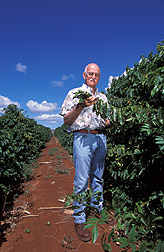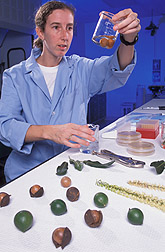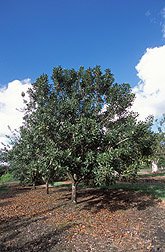From Hawaii to You: Flavorful Coffees and Creamy Macadamia Nuts |
|
 Plant physiologist Paul Moore examines coffee trees involved in genetic studies on the Island of Oahu. (K11227-1) |
You're relaxing at a neighborhood café, savoring a cup of your favorite roast and a decadent slice of chocolate macadamia nut torte. The tropical beans used to brew your coffee and the rich, buttery nuts embedded in the torte may have come to you from the farms of the sunny Hawaiian Islands. Scientists with the ARS U.S. Pacific Basin Agricultural Research Center in Hawaii, and their colleagues, are discovering more about the genetic makeup of these exotic tropical crops. Their research should benefit not only growers, but also coffee lovers and macadamia nut fans. One of the scientists' goals is to ensure that the genetic diversity, or gene pool, of both crops is preserved for the future. For example, as-yet-unknown genes in today's popular commercial coffee varieties or in their wild, uncultivated relatives might hold the key to innovative new coffees for tomorrow. In the case of macadamia, the investigations could streamline breeding of superior trees that boast genes for bigger yields of this premium nut. |
 In preparing to identify potential causal agents of grey kernel disease of macadamia, plant pathologist Lisa Keith examines macadamia nuts for hairline cracks, which seem to be necessary for symptoms to develop. (K11220-1) |
A Little History Macadamia nut and coffee plants sailed into Hawaii—literally—in the 1800s. Hawaii was an important stopping point for sailors to restock provisions needed for their long voyages. Though macadamia devotees may find it hard to believe, macadamia trees were first imported into Hawaii for landscaping and establishing pleasant woodlands, and only later were cultivated for their tasty, unusual nuts. Coffee was first transported to the Hawaiian Islands via a British gunship that was carrying home the bodies of King Kamehameha II and Queen Kamamalu, who had died of measles during a state visit to London. The ship took coffee trees aboard during a stopover for supplies in Rio de Janeiro. The rest is history. Both coffee and macadamia flourished in Hawaii's mild climate. Today, macadamia nuts—known as "mac nuts" to island locals—are grown mainly on the Big Island of Hawaii, while coffee is produced throughout the Hawaiian Islands, earning them their nickname "America's Coffee Islands." |
 Macadamia nuts, from Macadamia integrifolia. (K11222-1) |
Uncovering the Beans' Genes To discover more about coffee and macadamia nut genetic material, the researchers are examining the makeup of specific stretches of DNA. Snipping corresponding stretches from each of the individual species ensures a stable, valid basis of comparison. Any dissimilarities among the DNA samples could be important, helping reveal the location of interesting genes—such as one that makes a particular species more hardy or flavorful than others. Coffee plant leaves used for the tests came from a genebank assembled by University of Hawaii scientists and maintained by the grower-sponsored Hawaii Agriculture Research Center, based at Aiea. The researchers analyzed three coffee species from Africa, the likely origin of coffee. Coffea arabica, the source of today's premium beans, and C. canephora, known for the robusta beans commonly used for making instant coffees, are the two most widely grown coffees in the world. C. liberica is grown commercially in the Philippines as well as in parts of Africa. When researchers compared these species, they found significant variation: C. arabica, for example, was about 50 percent different from C. canephora and C. liberica. Says ARS plant physiologist Paul H. Moore, "The beans from these species make very different brews. The species grow at different elevations and differ in their resistance to pests. Perhaps some of those differences are reflected in the variations in the genetic material that we examined." |
 One of 43 macadamia accessions maintained as field plantings at the U.S. Pacific Basin Agricultural Research Center, in Hilo, Hawaii. (K11224-1) |
Nearly all the C. arabica varieties examined—Bourbon, Catimor, Catuai, Caturra, and Mokka Hybrid—were, on average, 93 percent similar among the stretches of DNA analyzed. Catimor and Mokka Hybrid differed the most from each other—information that could eventually result in a better cup of joe. Probe Zeros In on Mac Species America's official macadamia nut genebank at Hilo, Hawaii—about 45 minutes by plane from Honolulu—provided leaf samples for the macadamia nut study. ARS horticulturist Francis T.P. Zee manages the collection, which includes macadamia nut types grown in Hawaii, California, Australia, South Africa, and Thailand. The macadamia nut study is helping to clarify key genetic differences among four of the world's seven macadamia species, as well as a wild relative with the evocative name "rose nut," or Hicksbeachia pinnatifolia. Of the five species examined, only Macadamia integrifolia and M. tetraphylla bear edible nuts; M. ternifolia, M. hildebrandii, and rose nut do not. Scientists found that the two macadamia species that produce edible nuts were the most similar to each other. According to plant molecular geneticist Ray Ming of the Hawaii Agriculture Research Center, who led the investigation, macadamia nut species were, on average, about 26 percent different. This is a relatively high level of genetic diversity and means there's enough variation to breed unique new nuts for Hawaii's orchards—a boon for mac nut lovers around the world. These studies are the most comprehensive genetic analyses to date of cultivated arabica coffees and cultivated macadamia nut varieties—and the first to use a sophisticated laboratory technique called AFLP (amplified fragment length polymorphism). Delving even further into the variations among and within macadamia nut and coffee species may lead scientists to genes that control desirable traits, enabling future advances that may make your coffee and torte that much more delectable.—By Marcia Wood, Agricultural Research Service Information Staff. This research is part of Plant, Microbial, and Insect Genetic Resources, Genomics, and Genetic Improvement, an ARS National Program (#301) described on the World Wide Web at www.nps.ars.usda.gov. Paul H. Moore is with the USDA-ARS U.S. Pacific Basin Agricultural Research Center, Tropical Plant Physiology, Disease, and Production Unit, 99-193 Aiea Heights Drive, Aiea, HI 96701; phone (808) 486-5411, fax (808) 486-5020. Francis T.P. Zee is with the USDA-ARS U.S. Pacific Basin Agricultural Research Center, Pacific Basin Tropical Plant Genetic Resource Management Unit, P.O. Box 4487, Hilo, HI 96720; phone (808) 959-5833, fax (808) 959-3539. "From Hawaii to You: Flavorful Coffees and Creamy Macadamia Nuts" was published in the June 2004 issue of Agricultural Research magazine.
|






